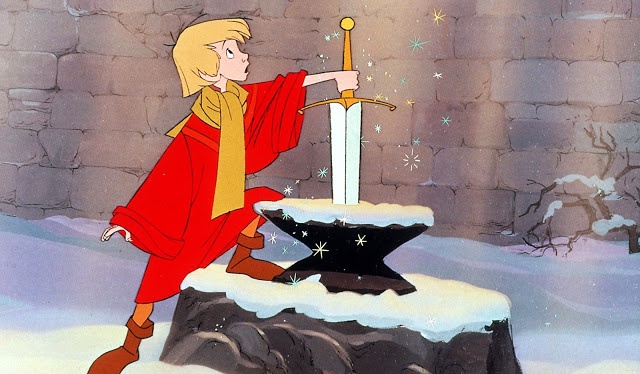
Thursday
In Monday’s and Tuesday’s posts (see here and here), I laid out the outlines of my first “Wizards and Enchantresses” class, which I’m currently teaching as part of Sewanee’s Lifelong Learning Program. The first class I devoted to Merlin, the second will focus on Morgan Le Fay, the third will take up Shakespeare’s Prospero, and the fourth will cover Harry, Hermione and other wizards in training (including Ged in Le Guin’s Earthsea Cycle and Kvothe in Patrick Rothfuss’s Name of the Wind.).
We barely reached Tennyson’s Merlin in yesterday’s class, but that was okay as we will be speaking to the poet’s ambivalent feelings about female power in next week’s class, which will help us understand the poet’s anxiety over Vivian’s seduction of the wizard. I’ll save for a future blog post my thoughts on that.
In my discussion of the 19th century, I talked about how, just as the scientific and technological revolutions ushered in a new appreciation for nature (we can only sentimentalize nature when we have achieved power over it), so they led people to reassess the Middle Ages. Rather than dismiss the period as barbaric and superstitious, Victorians like Tennyson looked to it for spiritual grounding and a sense of mystery. Note the magical pyrotechnics in Idylls of the King (1859-85) when Bellicent (Arthur’s half-sister) describes a vision that legitimates Arthur. Her source is a seer, Merlin’s teacher Bleys, who has come back from the dead to inform her:
And down the wave and in the flame was borne
A naked babe, and rode to Merlin's feet,
Who stoopt and caught the babe, and cried, 'The King!
Here is an heir for Uther!' And the fringe
Of that great breaker, sweeping up the strand,
Lashed at the wizard as he spake the word,
And all at once all round him rose in fire,
So that the child and he were clothed in fire.
And presently thereafter followed calm,
Free sky and stars: 'And this same child,' he said,
'Is he who reigns; nor could I part in peace
Till this were told.' And saying this the seer
Went through the strait and dreadful pass of death,
Not ever to be questioned any more
Save on the further side…
The Lifelong Learning class has both fantasy enthusiasts and those who wonder what all the fuss is about, which is making for some fascinating conversations. Tennyson’s dramatic rendition—which I likened to the theatrics of Excalibur since one of the students found the film magical—demonstrates how starved the age was for enchantment.
Idylls of the King was intended as the British Empire’s epic, just as The Aeneid was imperial Rome’s, but ultimately it reads more as an elegy. Victorian doubts have crept in, and the work is more about spiritual crisis than it is about the glories of the Round Table.
This crisis is dramatized in Mark Twain’s Connecticut Yankee in King Arthur’s Court (1889), told from the perspective of a hard driving capitalist who has no time for fantasy. Transported back in time to Camelot, Hank sees only an illiterate and superstitious populace manipulated by cynical con men. Chief among these is Merlin, who resembles the King and the Duke from Huckleberry Finn.
Hank thinks the marvels of enlightenment technology will overpower medieval thinking, but he doesn’t reckon on the need for transcendent belief. In the apocalyptic ending, modern weaponry is employed to slaughter people who can’t reconcile themselves to Hank’s sterile world. Writing in the age of the naturalist novel (Emile Zola, Stephen Crane, Frank Norris) and anticipating modernism, Twain captures the spiritual emptiness of industrial capitalism.
Writing in the wake of World War I, T. H. White turned to the Arthurian tales to recapture the enchantment that seemed to have drained from the world. Drawing on the shapeshifter Merlin of the medieval accounts, in Sword and the Stone (1938) he imagines the wizard as the teacher we’ve always wanted. White couldn’t sustain the childhood magic as Arthur grows up, however, and the series becomes increasingly dark. Arthur once was king but it’s not clear why anyone should believe he has a future. Merlin doesn’t appear to have a solution.
J. R. R. Tolkien too turned to fantasy to redeem the world, creating a vast imaginary universe designed to serve as an alternative to the horrors of the two world wars. Tolkien models Gandalf on Merlin and looks to him to guide the hobbits to spiritual wisdom. Yet in the end, magic leaves Middle Earth as the elves, Gandalf, Bilbo and Frodo all depart for the Grey Havens. No answers appear to exist for the crisis of modernity.
So is fantasy just a consoling escape from a grim reality or is it a way to keep alive a vision of a fuller life which, while under assault, may be viable? Jung talks about how our true Self turns to dream images to signal to the conscious mind the road we should travel if we are to realize this Self in the world. Joseph Campbell calls the process the journey of the hero, and both men found it powerfully articulated in fantasy.
The popularity, staying power, and influence of Lord of the Rings suggest that it is one of those fantasies. I would say the same about the Harry Potter series, which features its own Merlin figure in Dumbledore. The wise old man sets us on the right path and then gets out of the way, leaving it up to us to figure out how to bring a new reality into being. Fantasy is not the only kind of literature that assists us in this endeavor—every genre makes its own special contribution—but it is more than just a fantasy.

